On September 7, 2019 an extended family of PIRL collaborated with Maestro Clay C to produce Celestial Celebration: Music, Art, and Technology, a multimedia performance and installation inspired by the 50-year anniversary of the Apollo 11 Moon Landing. PIRL designed and built six interactive exhibits and collaborated with Dr. Christine Veras (ATEC/UT Dallas) and Dr. Donna Cox (AVL/NSCA/UIUC).
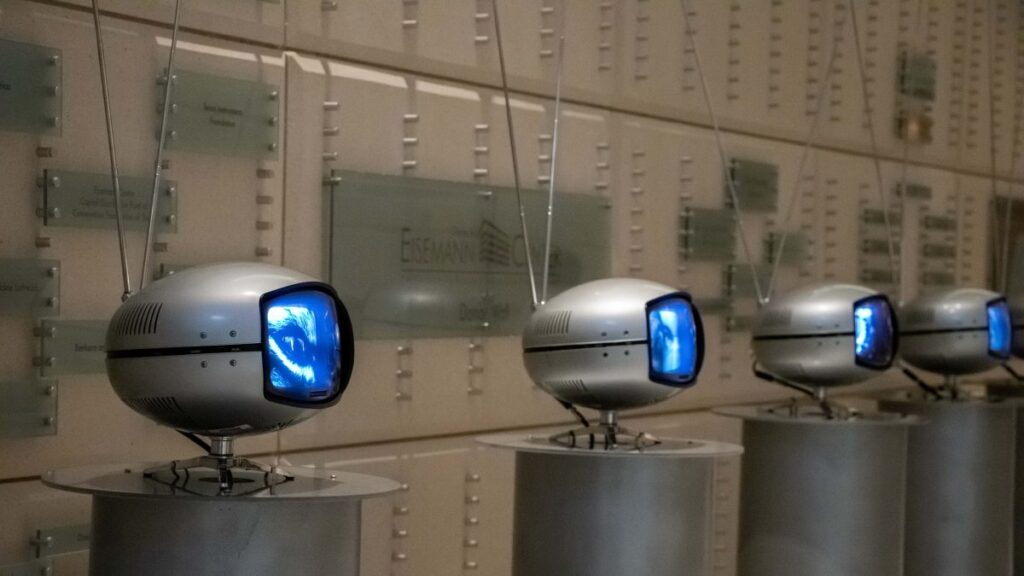
Colophon
Python
ReactJS
SpaceEngine
Phidget 3-axis accelerometer
Phidget High speed encoder
Siko Magnetic Position Sensor
Ideum Platform & Presenter
HighEnd Systems Solaspot Pro 2000 robotic light fixture
Laser projector
Gpredict (real-time satellite tracking and orbit prediction application)
Astrotables
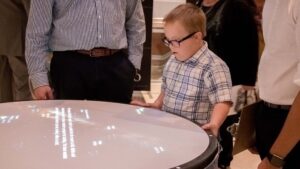
The Astrotables display custom-designed interactive visualizations using the Space Engine Universe Simulator. Originally produced by Onomy Labs, an Astrotable enables body-scale explorations of the Universe. The table becomes a computer interface device. Animated visualizations of space data are projected on the tabletop. Spinning the tabletop controls the magnification of the visualization; tilting the tabletop slides the image to change the view.
Celestial Powers of 10: Drawing inspiration from Charles and Ray Eames’ 1968 film Powers of Ten, this story enables the visitor to travel exponentially through a simulated universe. Starting at the Eisemann Center, 10,000 meters above, the visitor can leap by powers of 10 from the Earth to the “edge of the known universe.”
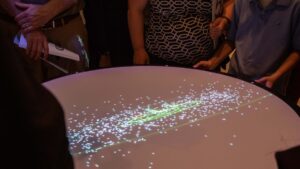
Touring Holst’s Planets: Gustav Holst’s orchestral suite, The Planets, composed from 1914-1916, presents a tour of the planets that could be seen from Earth in the early 20th century. Holst focused his interpretation on the astrological character of the gods for which each planet was named. This interactive experience enables a visitor to travel among planets to uncover astrological and astronomical stories.
Following Apollo 11: Visitors can follow the flightpath of Apollo 11, stopping at significant waypoints to read information about the mission and the views witnessed by the Apollo 11 crew.
Through the roof
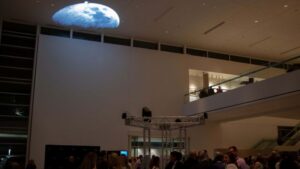
The U.S. Space Surveillance Network uses radar to track more than 13,000 human-made objects larger than four inches (ten centimeters). This celestial detritus includes everything from the International Space Station (ISS) and the Hubble Space Telescope, to defunct satellites, rocket stages, or nuts and bolts left behind by astronauts. There are millions of other smaller bits of space junk such as flecks of paint and bits of plastic. In 1969, the space around our planet was much less cluttered than it is now. Through the Roof uses lasers and lighting instruments to present a visualization of the moon and hundreds of other objects as they passed over the Eisemann Center on September 7th, 2019.
Touching Histories
Ideum Presenter display
UT Dallas official 50th anniversary web-based timeline available at: utdallas.edu/50
Archival materials provided by UT Dallas University Archives, Treasures @ UT Dallas, SMU Libraries, Internet Archive, The City of Dallas Vault
Project Description:
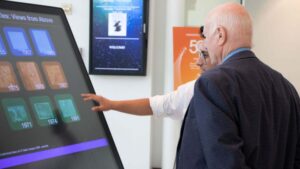
The 50-year history of the University of Texas at Dallas is deeply intertwined with Texas Instruments, the City of Richardson, and the technology-rich region of North Texas.
This large format touchscreen displays the official University timeline, produced by the UT Dallas Office of Communications, that describes the most important milestones in the 50-year growth of the University. The chronology references the contributions of noteworthy people, significant events, the expansion of the campus, and the launch of innovative educational and research programs.
This installation presents four additional interactive historical episodes. Guests are encouraged to explore the content to read how UTD campus traditions, institutional aspirations, and regional influence evolved over five decades.
Interactive History Episodes:
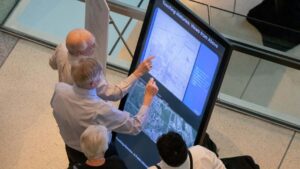
Campus Traditions
UT Dallas Connected
Views from Above
The Calculator: An evocative object for STEM education
Ideum Presenter display
UT Dallas official 50th anniversary web-based timeline available at: utdallas.edu/50
Archival materials provided by UT Dallas University Archives, Treasures @ UT Dallas, SMU Libraries, Internet Archive, The City of Dallas Vault
